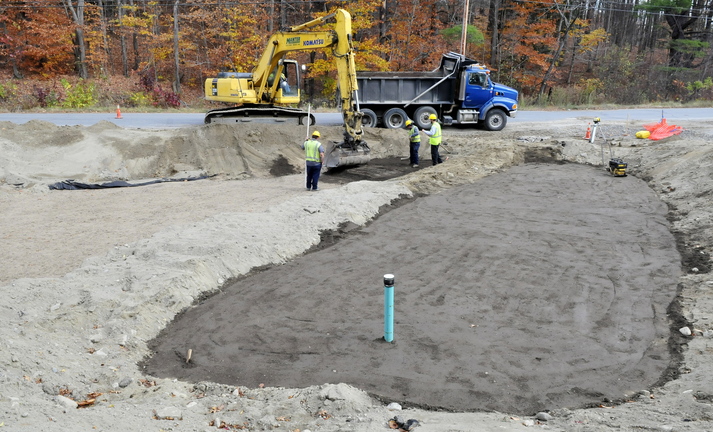SKOWHEGAN — By the time a Portland environmental group and the town’s economic development officials are done with the restoration of Whitten Brook watershed, the water will be clean enough to support a threatened brook trout population — right in the middle of town.
Whitten Brook, which flows from Russell Road, through neighborhoods, under streets and back yards and finally into the Kennebec River at Elm Street, is one of only two or three urban wild brook trout streams in Maine.
Pollution from storm water runoff into the stream from Madison Avenue, parking lots, driveways and lawns is sending petroleum products, pet waste, road salt and lawn fertilizer into the sensitive brook.
The plan, said Jennifer Jespersen of FB Environmental Associates of Portland, is to filter the runoff while encouraging area businesses and landowners to grow grass and other vegetation to naturally help with the filtering.
The result will be collection ponds, a small porous parking lot and a community demonstration area to illustrate examples of conservation practices and to showcase a restored brook trout habitat, Jespersen said.
“This includes a demonstration garden with dozens of species of native wildflowers and shrubs designed by Somerset Master Gardeners and a porous parking area that allows rain water to soak into the ground, rather than run off,” Jespersen said.
Work to be completed this week is centered around the former “corn factory” on Russell Road, where crews are excavating the collection ponds. A large, unused parking lot at the former factory recently was replaced with vegetation to limit the amount of run-off into the stream, she said.
Earth work began about two weeks ago, said Ed Mantor, of Mantor Construction of Sidney, which is doing the excavation.
“We’re installing the ponds for the filtration of the water,” Mantor said this week. Mantor said his crews will be done by the end of the week.
The filtering of the foreign material is to ensure that insects and invertebrate life, on which the brook trout and other wildlife feed, survive.
“The bugs tell the whole story,” Conservation Commission member Peter Whitkop said when the study first began in 2010. “We would like to improve the bug life so that it can support a viable trout population.”
The work is financed through an $88,649 grant accepted by the Skowhegan Board of Selectmen in April 2012 through the state Clean Water Act. The money is generated through the U.S. Environmental Protection Agency specifically for the Whitten Brook project through the Maine Department of Environmental Protection.
The stream in 2010 was officially designated as an urban impaired brook, which means it did not meet state water quality standards. The U.S. EPA wants to use the brook as a model for small streams in the state and around New England, Jespersen said.
The town of Skowhegan is matching the grant money with $14,233 of in-kind work from various town departments.
The filtering project is designed to treat solid material that winds up in the stream, along with phosphorous and zinc before it also enters the stream.
The Whitten Brook watershed covers about 300 acres, or about half a square mile from Coburn Avenue to the state fairgrounds, down Madison Avenue to Pleasant Street and finally to the river.
Doug Harlow — 612-2367
dharlow@centralmaine.comTwitter: @Doug_Harlow
Send questions/comments to the editors.




Success. Please wait for the page to reload. If the page does not reload within 5 seconds, please refresh the page.
Enter your email and password to access comments.
Hi, to comment on stories you must . This profile is in addition to your subscription and website login.
Already have a commenting profile? .
Invalid username/password.
Please check your email to confirm and complete your registration.
Only subscribers are eligible to post comments. Please subscribe or login first for digital access. Here’s why.
Use the form below to reset your password. When you've submitted your account email, we will send an email with a reset code.